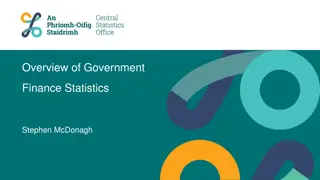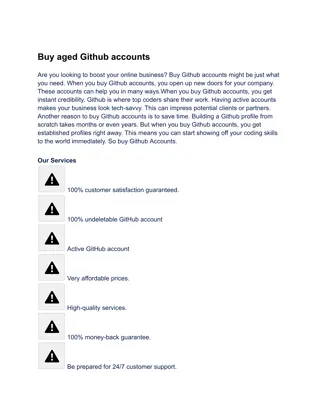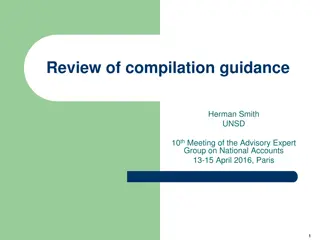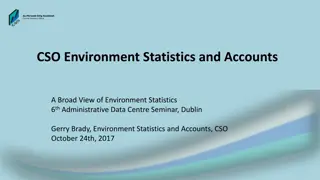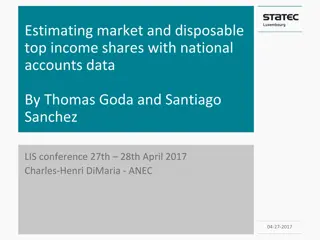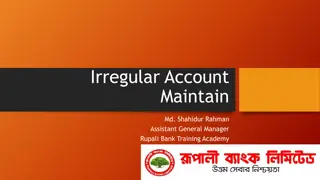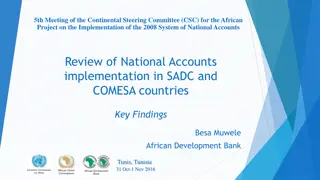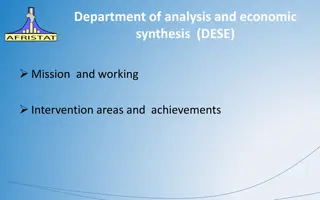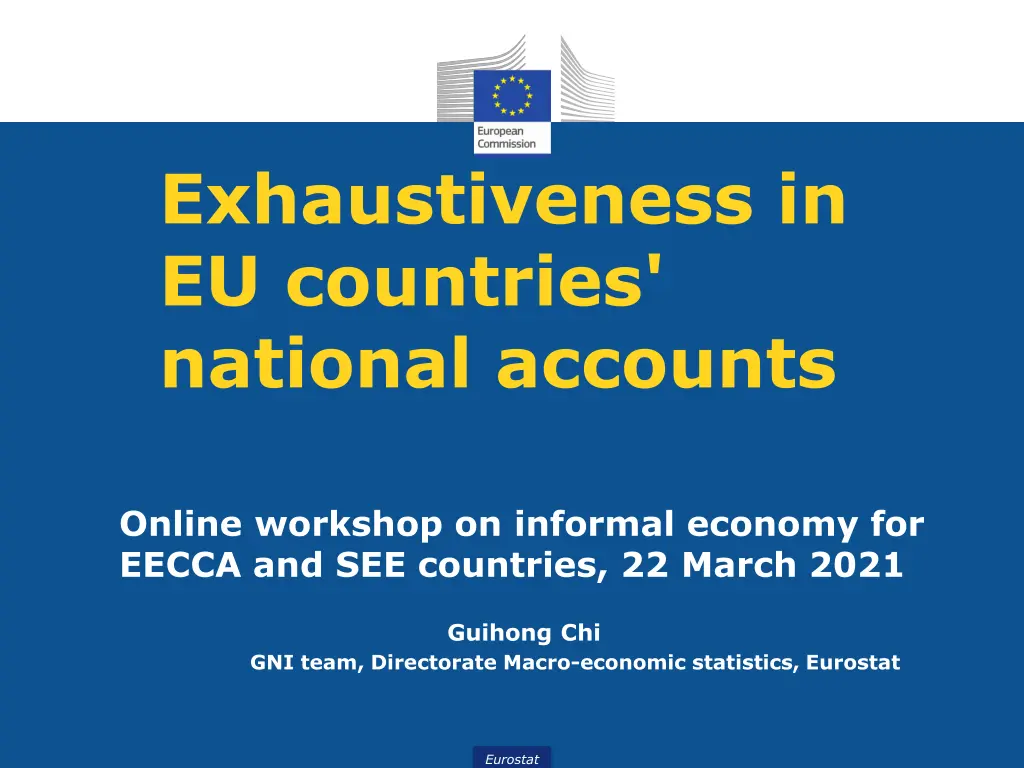
Approaches to Verify Exhaustiveness in EU National Accounts
Explore two different approaches employed in EU countries to measure the non-observed economy (NOE) and ensure exhaustiveness in national accounts. Learn about the key points of the Eurostat Tabular Approach on Exhaustiveness (TAE) and the verification processes conducted by the GNI team of Eurostat. Discover how systematic assessments and adjustments are made to achieve comprehensive estimates of GDP/GNI.
Download Presentation

Please find below an Image/Link to download the presentation.
The content on the website is provided AS IS for your information and personal use only. It may not be sold, licensed, or shared on other websites without obtaining consent from the author. If you encounter any issues during the download, it is possible that the publisher has removed the file from their server.
You are allowed to download the files provided on this website for personal or commercial use, subject to the condition that they are used lawfully. All files are the property of their respective owners.
The content on the website is provided AS IS for your information and personal use only. It may not be sold, licensed, or shared on other websites without obtaining consent from the author.
E N D
Presentation Transcript
Exhaustiveness in EU countries' national accounts Online workshop on informal economy for EECCA and SEE countries, 22 March 2021 Guihong Chi GNI team, Directorate Macro-economic statistics, Eurostat Eurostat
Two different approaches to capture Non- Observed Economy (NOE) Exhaustiveness: to measure total economic activity and to produce exhaustive macro-economic estimates (GDP/GNI); exhaustiveness adjustments can include NOE implicitly and/or explicitly. Measuring individual areas of NOE e.g. Informal Sector Production: to estimate the size of individual areas of NOE explicitly; to support policy analysis. Terminologies, data sources and methods for the two approaches can overlap. This presentation is on Exhaustiveness. 2
Overview Approach to the verification of exhaustiveness Cross-country comparison (CCC) on exhaustiveness Work in the future 3
Eurostat Tabular Approach on Exhaustiveness (TAE) In scopeof survey or administrative collection Notin scope ofsurvey or administrative collection Unregistered Producer should have registered (underground producer) Misreporting by the producer Illegal Registered legal person is not included in statistics Registered entrepreneur is not included in statistics Producer isnot obliged to register Statistical deficiencies in thedata producer that fails to register N2 N3 N1 N4 N5 N6 N7 4
TAE: key points The non-exhaustiveness types (N-types) are classified by making use of producers characteristics in combination with the data sources used for the GDP output approach. The N-types are used to assess systematically potential non- exhaustiveness and to make adjustments to achieve exhaustiveness of the GDP/GNI estimates. The individual size of a N-type is not critical. N-types can be implicitly and/or explicitly included in the estimates. More than one N-type can be estimated together. Developed and tested in the context of several Phare projects for EU candidate countries on the improvement of consistency, reliability and exhaustiveness of their national accounts (NA) (mainly in the period between 1998 and 2003). From 2016, used by all EU Member States (MS) as a general framework for presenting their work on exhaustiveness. Detailed information: see guidelines TAE (distributed). 5
Verification of exhaustiveness: Performed by: the GNI team of Eurostat. Timing: during a GNI verification cycle: Last: ESA2010 verification cycle 2016-2019. Current: ESA2010 verification cycle 2020-2024. Legal acts: GNI Regulation Commission Decision on exhaustiveness GNI Inventories (ESA 2010): Chapter 7 Overview of the allowances for exhaustiveness. The CCC exercise in the cycle 2016 -2019. More information: public folder Monitoring GNI for own resource purposes. 6
Overview Approach to the verification of exhaustiveness Cross-country comparison (CCC) on exhaustiveness Work in the future 7
NOE adjustments for the Production Account (as % of GDP) in EU MS (GNI Inventories for the cycle 2016-2019) 35 33,1 30 25 19,3 20 15 10 8,2 6,6 4,9 5 3,5 3,5 2,7 1,6 1,30,5 1,30,5 1,2 1,1 0,9 0,6 0,1 0,1 0,1 0,1 0 0 0 0 N1 N2 N3 N4 N5 N6 N7 TOTAL MIN MAX AVG 8
Priority areas investigated Balancing vs NOE adjustments N6- misreporting Employment method (=Labour Input Method) VAT fraud and N6 9
One example of analysis: Employment method Another name: Labour Input Method (LIM). Important usages: Validation of employment underlying GNI estimates required by Commission Decision on Exhaustiveness (94/168). Exhaustiveness adjustments (N1, N3 to N6). 10
Employment method: principle DEMAND of Labour (BS) SUPPLY of Labour (LFS) Measurement of labour: FTE or hours worked. Labour force survey (LFS) is usually more exhaustive than Business Survey (BS). The supply (S) data are used to complete the demand (D) data (basis for GDP/GNI estimates). 11
Application of labour input method (EU MS) Number of MS 12 Min Max AVG Adjustments made via LIM Share in % of GDP Share in % of NOE Reasons for not making adjustments 0,3 6,0 21,6 87,0 5,2 39,4 S=D S<D S>D* LIM not applied 6 5 1 4 NB. * Adjustments made via another method (fiscal audit) prevailed. 12
Employment method: major findings Diverse application of the method depending on economic character and available data sources in each MS. Identified issues for follow-up to enhance comparability: Harmonisation of data on employment (the precise adjustments needed). If S<=D, further investigations: under reporting of LFS, analysis of other labour inputs. The transition from extra labour inputs to non- observed output/GVA: define the right comparable segments, productivity ratios and conditions for imputing extra IC. Current guidance (by European Commission and OECD) provides few practical details on the application of LIM. 13
Exhaustiveness of NA in the EU: conclusions In general, MS have established adequate systems for identifying exhaustiveness gaps and addressing them in their NA. Practical guidance for individual methods is needed. Proposal to set up a GNI Expert Group sub-group on exhaustiveness. 14
Overview Approach to the verification of exhaustiveness Cross-country comparison (CCC) on exhaustiveness Work in the future 15
GNI Expert Group sub-group on exhaustiveness Main objective: develop practical guidance and identify good practices for enhanced comparability. Scope: 3 priority areas that cover in total 11 issues to be investigated. Time period: 2021- 2023. The coordinating body: GNI team of Eurostat. 9 MS volunteered for membership: BE, CZ, DE, ES, FR, HU, IT, PL, SK. Outcome: guidance in the form of a report for each area. 16
1. Misreporting This area aims at identifying good practices and developing practical guidance for the two selected issues. Two selected issues will be investigated: 1. Reference income method, 2. Adjustments to IC for misreporting. 17
2. Employment method This area aims at identifying good practices and developing practical guidance for the open issues in the application of the employment method. Five open issues will be investigated: 1.Scrutinize the basic steps of the employment method by means of country presentations, 2. Harmonisation of data on employment from LFS and BS, 3. Underreporting of LFS, 4. Analysis of other labour inputs, 5.The transition from extra labour inputs to non-observed output/GVA. 18
3. Non-collected VAT and exhaustiveness adjustments This area explores the estimations of the theoretical VAT and the links between the non-collected VAT and the underlying exhaustiveness adjustments. Practical guidance will be developed. Four issues will be investigated: 1. Estimation of theoretical VAT, 2.Identification of non-collected VAT by non- exhaustiveness types, 3.Implicit coverage of non-collected VAT by exhaustiveness adjustments, 4.Validation of exhaustiveness adjustments through the analysis of the relation between the estimated non- collected VAT. 19





